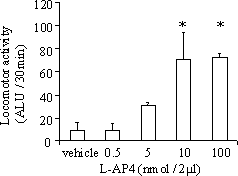| pA2
online © Copyright 2003 The British Pharmacological Society |
014P
University of Bristol 1st Focused Meeting April 2003 |
The group III mGlu receptor agonist,L-AP4, reverses akinesia in the reserpine-treated rat and inhibits [3H]D-aspartate release from rat nigral slicesM.J. Messenger,
K. Greenwood & S. Duty. |
Search PubMed for: |
Group III metabotropic glutamate (mGlu) receptors reside on the terminals of overactive GABAergic striatopallidal and glutamatergic subthalamonigral pathways (e.g. Marino et al., 2002) that contribute to the generation of akinetic symptoms in Parkinson's disease (PD). If these receptors act to mediate inhibition of transmitter release from these pathways, group III mGlu agonists may provide relief from akinesia. The aims of this study were, therefore, to establish whether the selective group III mGlu receptor agonist L-AP4 (i) inhibited either GABA release in the globus pallidus (GP) or glutamate release in the substantia nigra pars reticulata (SN) and (ii) reversed akinesia in the reserpine-treated rat.
Under general halothane anaesthesia, male Sprague Dawley rats (~280g) were cannulated in the 3rd ventricle and rendered akinetic 4d later with reserpine (5mg kg-1s.c.). 18h later, single intraventricular injections (2µl) of L-AP4 (0.5-100nmol) or vehicle (PBS/NaOH; pH 7.4) were made and locomotor activity, measured for 30 min post injection, was scored in arbitrary locomotor units (ALU). [3H]D-aspartate release (an index of glutamate release) from rat SN slices or [3H]GABA release from rat GP slices was measured using a two-stimulation KCl (25mM)-evoked paradigm as previously described (Chadha et al., 2000). Transmitter release was measured before (S1) and after (S2) the addition of L-AP4 (1-300µM) or vehicle (Krebs') and the S2/S1 ratio taken as a measure of release. In both studies, the effects of L-AP4 werecompared using a 1-way ANOVA, with a Dunnett's post hoc test, where P<0.05 is significant.
In reserpine-treated rats, L-AP4 produced a dose-dependent reversal of akinesia, reaching significance at 10 and 100 nmol (Figure 1). L-AP4 failed to significantly inhibit [3H]GABA release from GP slices at any concentration tested. In contrast, at the highest concentration tested (300 µM), L-AP4 significantly inhibited [3H]D-aspartate efflux from SN slices by 48.6 ± 11.7% (mean ± s.e.mean, n=8 animals).

Fig. 1. L-AP4 induced locomotor activity in reserpine-treated rats. Data are mean ± s.e.m (n=5-9 rats /dose). *versus vehicle.
In conclusion, these data fail to support an heteroreceptor role of group III mGlu receptors in the GP. However, these receptors appear to function as autoreceptors in the SN where the effective reduction in glutamate release may underlie the anti-akinetic effect of L-AP4 in reserpine-treated rats.
Supported by the Wellcome Trust.
Chadha A. et al.,
(2000). Br. J. Pharmacol., 130, 1927-1932.
Marino M.J. et al., (2002). Amino Acids, 23, 185-191.